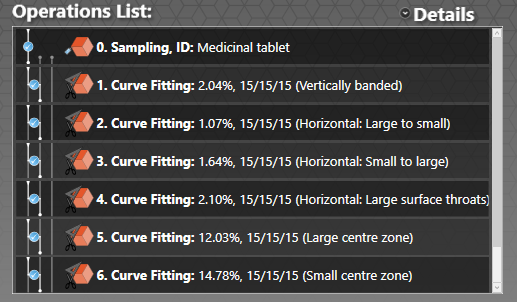To follow this tutorial, you need the datafile shown in the previous section. If you have been following the tutorial, then you will have this data file to hand. If not, it is in the Advanced Tutorial Artefacts.zip datafile downloadable from the datafile downloads page of the website. The zip file contains the required Medicinal tablet edited.csv file.
There are various caveats regarding the following exercise. The first is that the edited data file has a shape that PoreXpert finds relatively easy to fit, whereas your own percolation curves may be much more difficult to fit, especially if they have a less sigmoid shape and much larger void size range. The second is that for speed of calculation, we will use a 15x15x15 unit cell, whereas for research purposes, you should typically be using a 25x25x25 grid. If you are running PoreXpert on a super-computer, you could use 30x30x30 unit cells. Finally, so that our results and yours match, we will run the fitting exercise with the learning mode switched off. However, in practice, you should always leave it switched on so that PoreXpert learns about your samples.
Open PoreXpert, and click on Open an existing file. Find and select the Medicinal tablet edited.csv datafile and Accept it. At the Curve Fitting screen, instead of clicking Accept (which leads to a single automated fit with the default structure type), click Go home. Then Pore batch | Open batch description, and find and select the file fitting_5_stoch_gens_HLtoS_noLearn_batch.pXt . Then PoreBatch | Run batch list .
After calculation, the Operations List screen should look like this (as also listed in Medicinal_Tablet_fitting_5_stoch_gens_HLtoS_noLearn.pXt ) :

The percentages are the distances (fit discrepancies) for each structure type. It can be seen that the minimum distance (best fit) is for the Horizontal: Large to Small structure type. As we have no other basis on which to choose a structure type, then in this case we will proceed with using this type.
However, there are two circumstances when you may wish to use a structure type that is not the best fit. The first is if you are studying a sample when, because of microscopy or manufacturing process for example, you know the most appropriate structure type to use - but remember that the void size auto-correlations are over very small distances, of the order of two or three times the largest void size that you are modelling. The second is when you are calculating a property and wish to find outer bounds for the estimate of that property. The most obvious example is when wanting to estimate absolute permeability (from which relative permeability estimates can also be derived). In that case you need to choose one structure type where the correlations are in layers parallel to the direction of fluid flow, typically a vertically banded structure, which will give you the upper bound of the estimated permeability (network flow capacity) and compare that with using the optimum stochastic generation derived from a horizontally banded structure such as the one we are about to use, i.e. Horizontal: Large to small, which will give you the lower bound. By so doing you are dealing with another artefact - the fact that the unit cells are infinitely replicated in each Cartesian direction. So if a vertically banded structure happens not to have any hindrances to flow in the largest of its layers, which is parallel to the direction of fluid flow, then that effect will be magnified by replication. Similarly, if a horizontally banded structure happens to impede the flow, then that impedance will be infinitely replicated. In natural samples there are always heterogeneities at some scale that allow limited flow.
We are now ready to consider choice of the optimum stochastic realisation.